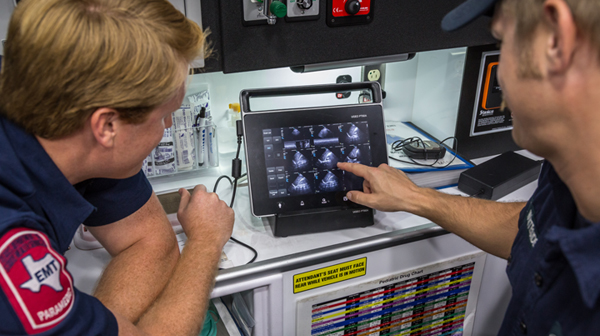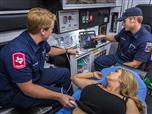
Earlier this month, paramedics in the Dallas–Fort Worth (DFW) area responded to a call involving a patient with shortness of breath. While still in the field, the medics performed an ultrasound and found the patient was suffering a spontaneous pneumothorax.
“Because they were able to see that, they were able to dart the chest, and at the hospital, they were able to put a chest tube in earlier,” said Bobby Sewell, chief of the Bedford Fire Department, near the DFW airport.
Six emergency vehicles in the DFW metropolitan area were recently equipped with brand-new Samsung PT60A ultrasounds as part of an ongoing trial to examine how a portable, tablet-based ultrasound system may transform emergency care in the field. If the trial results so far are any indication, big changes are on the horizon.
“This trial was designed for the fact that, when you go out to some of these trauma situations, you would like to make a quick evaluation or assessment of the patient,” said Thad Chodakauskas, senior product manager for Samsung’s Health & Medical Equipment division. “Paramedics can transmit images wirelessly to the emergency department, which can make the decision whether the patient needs to go to the emergency room or directly to the OR.”
While results from the DFW trial have not yet been published, some of its major findings to date were announced in October: wireless transmission of ultrasound images from the field—in some cases within 30 seconds—resulted in faster treatment upon patient arrival at the ED, and DFW-area medics were able to detect heart movement by ultrasound in multiple patients presenting with no pulse and continue treatment, resulting in eventual patient discharge.
More than 50 paramedics were trained on the ultrasound and tested by the local partnering trauma center, John Peter Smith Hospital. They successfully transmitted images wirelessly to the hospital and EMS medical director, Roy Yamada, MD. Sewell said physicians can receive the images on smartphones and iPads and that trauma centers can notify the on-duty ED staff while medics are en route.
“We are shortening the hours of response time down to preserve the golden hour,” said Sewell.
The medical team plans to publish full results in the first half of 2015, Chodakauskas said, and is currently working to gather more data, particularly on how the technology—based on Samsung’s Galaxy tablet platform—improves patient outcomes.
Pages: 1 2 | Single Page






No Responses to “Tablet-Based Ultrasound Tech in Emergency Services Vehicles Can Speed Care in the ED”